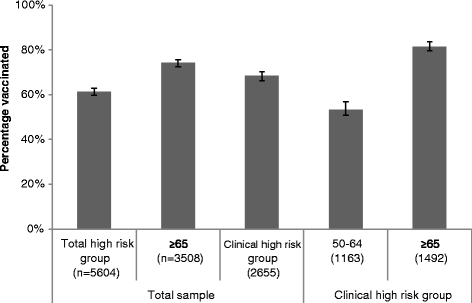The influence of partial public reimbursement on vaccination uptake in the older population: a cross-sectional study
- PMID: 25652743
- PMCID: PMC4328256
- DOI: 10.1186/s12889-015-1356-7
The influence of partial public reimbursement on vaccination uptake in the older population: a cross-sectional study
Abstract
Background: Flu vaccination is recommended annually for high risk groups. However, in Ireland, free access to vaccination is not universal for those in high risk groups; the vaccine and consultation are only free for those with a medical card, a means tested scheme. Few private health insurance policies cover the cost of attendance for vaccination in general practice. The aim was to examine the influence of this reimbursement policy on vaccination coverage among older adults.
Methods: Cross-sectional wave 1 data from The Irish Longitudinal Study on Ageing (TILDA) were analysed (2009-2011). TILDA is a nationally representative prospective cohort study of adults aged ≥50, sampled using multistage stratified clustered sampling. Self-reported entitlement to healthcare was categorised as 1) medical card only 2) private health insurance only, 3) both and 4) neither. The outcome was responses to 'have you ever had a flu shot'. Multivariate logistic regression was used, adjusting for age and need.
Results: 68.6% of those defined as clinically high-risk received the flu vaccination in the past (95% CI = 67-71%). Those with a medical card were almost twice as likely to have been vaccinated, controlling for age and chronic illness (OR = 1.9, 95% CI = 1.5-2.5, p = <0.001).
Conclusions: Having a medical card increased the likelihood of being vaccinated, independent of age and need. The mismatch between vaccination guidelines and reimbursement policy is creating unequal access to recommended services among high risk groups.
Figures
Similar articles
-
The free vaccination policy of influenza in Beijing, China: The vaccine coverage and its associated factors.Vaccine. 2016 Apr 19;34(18):2135-40. doi: 10.1016/j.vaccine.2016.02.032. Epub 2016 Feb 23. Vaccine. 2016. PMID: 26917011
-
Low vaccination coverage for seasonal influenza and pneumococcal disease among adults at-risk and health care workers in Ireland, 2013: The key role of GPs in recommending vaccination.Vaccine. 2016 Jul 12;34(32):3657-62. doi: 10.1016/j.vaccine.2016.05.028. Epub 2016 Jun 7. Vaccine. 2016. PMID: 27255466
-
Influenza vaccination among the elderly Spanish population: trend from 1993 to 2003 and vaccination-related factors.Eur J Public Health. 2007 Jun;17(3):272-7. doi: 10.1093/eurpub/ckl242. Epub 2006 Oct 27. Eur J Public Health. 2007. PMID: 17071634
-
The impact of socioeconomic level on influenza vaccination among Italian adults and elderly: a cross-sectional study.Prev Med. 2007 Nov;45(5):373-9. doi: 10.1016/j.ypmed.2007.07.007. Epub 2007 Jul 17. Prev Med. 2007. PMID: 17707499
-
On the Influence of Vaccination upon Population.Edinb Med Surg J. 1814 Jan 1;10(37):89-97. Edinb Med Surg J. 1814. PMID: 30329387 Free PMC article. Review. No abstract available.
Cited by
-
Exploring the association between primary care efficiency and health system characteristics across European countries: a two-stage data envelopment analysis.BMC Health Serv Res. 2023 Dec 4;23(1):1348. doi: 10.1186/s12913-023-10369-y. BMC Health Serv Res. 2023. PMID: 38049793 Free PMC article.
-
Understanding the Influence of Individual and Systemic Factors on Vaccination Take-Up in European Citizens Aged 55 or Older.Vaccines (Basel). 2021 Feb 17;9(2):169. doi: 10.3390/vaccines9020169. Vaccines (Basel). 2021. PMID: 33671437 Free PMC article.
References
-
- Nicoll A, Ciancio B, Tsolova S, Blank P, Yilmaz C. The scientific basis for offering seasonal influenza immunisation to risk groups in Europe. Euro surveillance. 2008;13(43). - PubMed
Publication types
MeSH terms
Substances
LinkOut - more resources
Full Text Sources
Other Literature Sources
Medical
Miscellaneous


